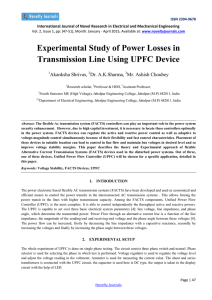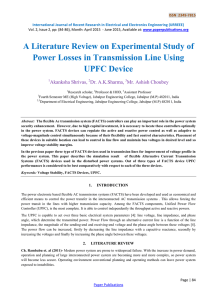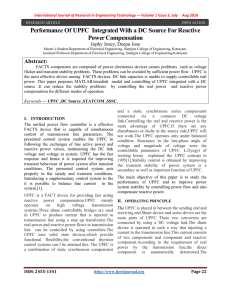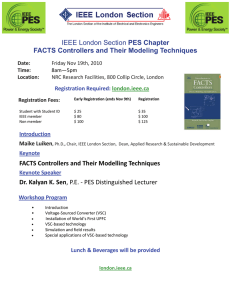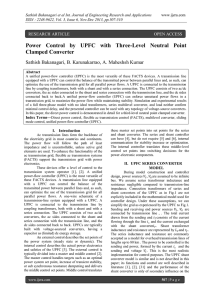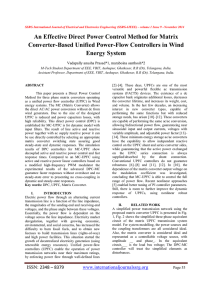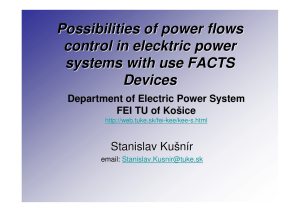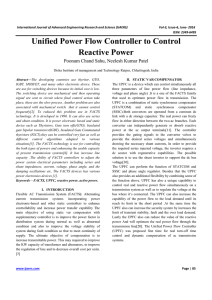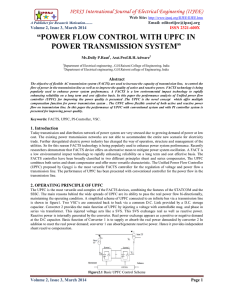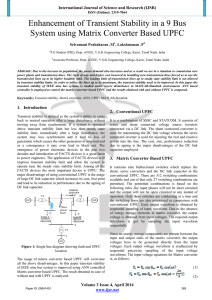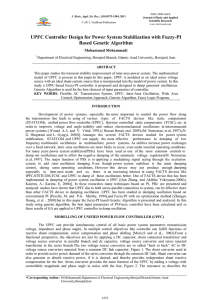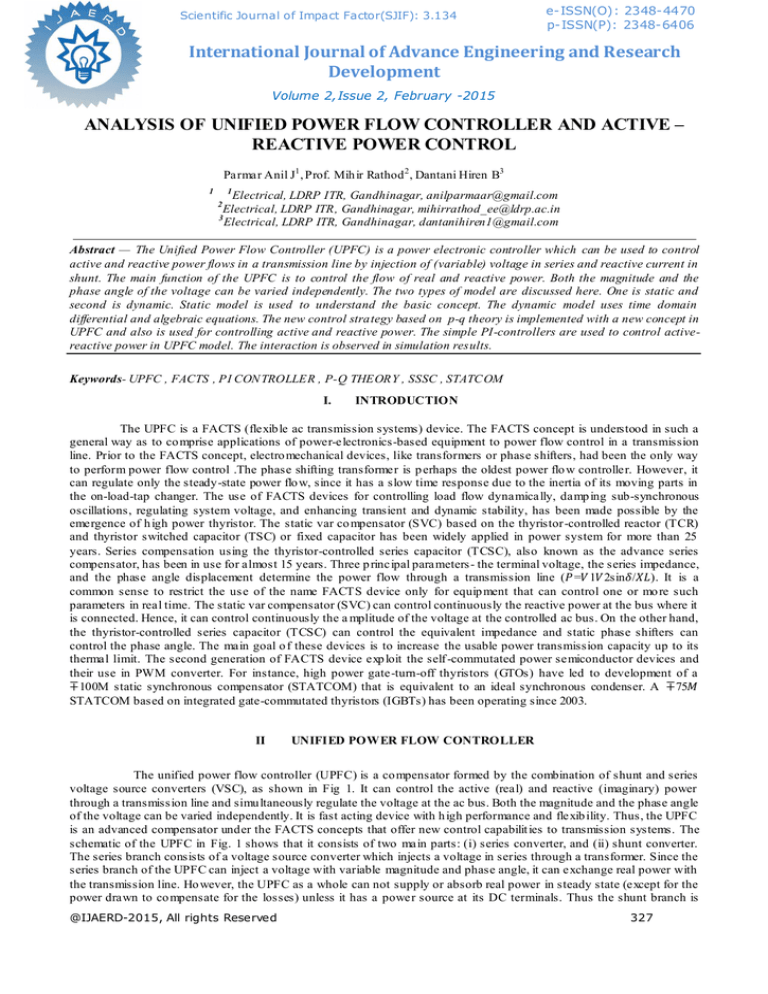
Scientific Journal of Impact Factor(SJIF): 3.134
e-ISSN(O): 2348-4470
p-ISSN(P): 2348-6406
International Journal of Advance Engineering and Research
Development
Volume 2,Issue 2, February -2015
ANALYSIS OF UNIFIED POWER FLOW CONTROLLER AND ACTIVE –
REACTIVE POWER CONTROL
Parmar Anil J1 , Prof. Mih ir Rathod 2 , Dantani Hiren B3
1
1
Electrical, LDRP ITR, Gandhinagar, anilparmaar@gmail.com
Electrical, LDRP ITR, Gandhinagar, mihirrathod_ee@ldrp.ac.in
3
Electrical, LDRP ITR, Gandhinagar, dantanihiren1@gmail.com
2
Abstract — The Unified Power Flow Controller (UPFC) is a power electronic controller which can be used to control
active and reactive power flows in a transmission line by injection of (variable) voltage in series and reactive current in
shunt. The main function of the UPFC is to control the flow of real and reactive power. Both the magnitude and the
phase angle of the voltage can be varied independently. The two types of model are discussed here. One is static and
second is dynamic. Static model is used to understand the basic concept. The dynamic model uses time domain
differential and algebraic equations. The new control stra tegy based on p-q theory is implemented with a new concept in
UPFC and also is used for controlling active and reactive power. The simple PI-controllers are used to control activereactive power in UPFC model. The interaction is observed in simulation results.
Keywords- UPFC , FACTS , PI CON TROLLER , P-Q THEORY , SSSC , STATC OM
I.
INTRODUCTION
The UPFC is a FACTS (flexib le ac transmission systems) device. The FACTS concept is understood in such a
general way as to co mprise applications of power-electronics-based equipment to power flow control in a transmission
line. Prior to the FACTS concept, electro mechanical devices, like transformers or phase shifters, had been the only way
to perform power flow control .The phase shifting transformer is p erhaps the oldest power flo w controller. However, it
can regulate only the steady-state power flo w, since it has a slow time response due to the inertia of its moving parts in
the on-load-tap changer. The use of FACTS devices for controlling load flow dynamically, damp ing sub-synchronous
oscillations, regulating system voltage, and enhancing transient and dynamic stability, has been made possible by the
emergence of h igh power thyristor. The static var co mpensator (SVC) based on the thyristor-controlled reactor (TCR)
and thyristor switched capacitor (TSC) or fixed capacitor has been widely applied in power system for more than 25
years. Series compensation using the thyristor-controlled series capacitor (TCSC), also known as the advance series
compensator, has been in use for almost 15 years. Three p rincipal parameters - the terminal voltage, the series impedance,
and the phase angle displacement determine the power flow through a transmission line (𝑃=𝑉1𝑉2sin𝛿/𝑋𝐿). It is a
common sense to restrict the us e of the name FACTS device only for equip ment that can control one or mo re such
parameters in real time. The static var compensator (SVC) can control continuously the reactive power at the bus where it
is connected. Hence, it can control continuously the a mplitude of the voltage at the controlled ac bus. On the other hand,
the thyristor-controlled series capacitor (TCSC) can control the equivalent impedance and static phase shifters can
control the phase angle. The main goal o f these devices is to increase the usable power transmission capacity up to its
thermal limit. The second generation of FACTS device exp loit the self -commutated power semiconductor devices and
their use in PWM converter. For instance, high power gate-turn-off thyristors (GTOs) have led to development of a
∓100M static synchronous compensator (STATCOM) that is equivalent to an ideal synchronous condenser. A ∓75𝑀
STATCOM based on integrated gate-commutated thyristors (IGBTs) has been operating since 2003.
II
UNIFIED POWER FLOW CONTROLLER
The unified power flow controller (UPFC) is a co mpensator formed by the combination of shunt and series
voltage source converters (VSC), as shown in Fig 1. It can control the active (real) and reactive (imaginary) power
through a transmission line and simu ltaneously regulate the voltage at the ac bus. Both the magnitude and the phase angle
of the voltage can be varied independently. It is fast acting device with h igh performance and flexib ility. Thus, the UPFC
is an advanced compensator under the FACTS concepts that offer new control capabilit ies to transmission systems. The
schematic of the UPFC in Fig. 1 shows that it consists of two main parts: (i) series converter, and (ii) shunt converter.
The series branch consists of a voltage source converter which injects a voltage in series through a transformer. Since the
series branch of the UPFC can inject a voltage with variable magnitude and phase angle, it can exchange real power with
the transmission line. Ho wever, the UPFC as a whole can not supply or absorb real power in steady state (except for the
power drawn to co mpensate for the losses) unless it has a power source at its DC terminals. Thus the shunt branch is
@IJAERD-2015, All rights Reserved
327
International Journal of Advance Engineer ing and Research Development (IJAERD)
Volume 2,Issue 2, February -2015, e-ISSN: 2348 - 4470 , print-ISSN:2348-6406
required to compensate (from the system) for any real power drawn, supplied by the series branch and the losses. In
addition the shunt converter can independently exchange reactive power with the system through the transformer
connecting it with the power system.
Fig 1 combined series and shunt power Conditioner
The UPFC consists of two branches. The series branch consists of a voltage source converter which in jects a voltage in
series through a transformer. Since the series branch of the UPFC can inject a voltage with variab le magn itude and phase
angle it can exchange real power with the transmission line. The energy storing capacity of this dc capacitor is generally
small. Therefore, active power drawn by the shunt converter should be equal to the active power generated by the series
converter. The reactive power in the shunt or series converter can be chosen independently, giving greater flexib ility to
the power flow control. The coupling transformer is used to connect the device to the system. Fig 2 shows the schematic
diagram of the three phase UPFC connected to the transmiss ion line.
However the UPFC as a compensator cannot supply or absorb real power in steady state (except for the power drawn to
compensate f or the losses) unless it has a power source at its DC terminals. Thus the shunt branch is required to
compensate (fro m the system) for any real power drawn/ supplied by the series branch and the losses. If the power
balance is not maintained, the capacitor cannot remain at a constant voltage. In addition to maintain ing the real power
balance, the shunt branch can independently exchange reactive power with the system. The main advantage of the power
electronics based FACTS controllers over mechanical controllers is their speed. Therefore the capabilities of the UPFC
need to be exploited not only for steady state load flow control but also to improve stability.
@IJAERD-2015, All rights Reserved
328
International Journal of Advance Engineer ing and Research Development (IJAERD)
Volume 2,Issue 2, February -2015, e-ISSN: 2348 - 4470 , print-ISSN:2348-6406
Fig 2 Schematic diagram of the three phase UPFC connected to the transmission line.
III.
PI CONTROLLER
The PI-controller is used as a basic controller to check the performance of U PFC. Static model is used to
understand the basic concept. The dynamic model of UPFC consists of time do main differential and algebraic equations.
Due to the equation based modelling, the parameter of UPFC is changed according to requirement of case study . The
basic controller which is known as PI-controller is used to control active and reactive power in UPFC model. Here, also
the error signal gives to PI-controller. The PI-controller’s output is active power reference of shunt converter. The error
signal generated by comparing reference current with actual current is given to the controller in Figure 4.1. The controller
is Propositional and integral (PI)-controller. The PI-controller has two control parameters(𝐾𝑝,𝐾𝑖). The controller gain is
choosing such a way that it gives the required output from UPFC. Each current component required separate PI controller.
IV.
P-Q THEO RY
The new control strategy based on p-q theory is used for controlling active and reactive power. The paper
introduces the basic operating principle of UPFC with p -q theory. This theory is important for calculat ing a reference
value for series and shunt converter. We also use this theory in formu lating d ynamic model of UPFC. The p-q theory is
based on a set of instantaneous powers defined in the time domain. Another way to introduce the p -q theory for threephase system is to use the instantaneous voltage and current vectors.
V
RES ULT OF S IMULATION
(1) Active Power Change on Reactive Power
@IJAERD-2015, All rights Reserved
(2) Reactive Power Change On Active power
329
International Journal of Advance Engineer ing and Research Development (IJAERD)
Volume 2,Issue 2, February -2015, e-ISSN: 2348 - 4470 , print-ISSN:2348-6406
ACKNOWLEDGMENT
I sincerely express my deep sense of reverential gratitude to my guide Mr. M ihir Rathod, Associate
Professor, Depart ment of Electrical Engineering, LDRP Institute of Technology & Research, Gandhinagar, for his
valuable suggestions, constant encouragement and unflinching co-operation throughout this work. I want to thank my
family for always being there for me. Their love, constant support and encouragement to pursue my goals made this
thesis possible. Special thanks to my colleague and friends for useful advice as well as help and support.
R EFERENCES
[1] L.Gyugyi, C.D.Schauder, S.L.Williams, T.R.Riet man, A.Edris “The Unified Power Flo w Controllers: A New
Approach to Power Transmission control” IEEE Transactions on Power Delivery, Vol.10, No.2, April 1995.
[2] S D Round, Q Yu , L E Noru m, T M Undeland, “Perfor mance of a Unified Po wer Flo w Controller using a D-Q
Control System” AC and DC Po wer Transmission, IEEE, 1996, pp 357-362.
[3] Q.Yu, S.D.Round, L.E.Nuru m, T.M.Undeland, “Dynamic Control of a Un ified Po wer Flow Controller”, IEEE,
1996, pp 508-514.
[4] A.M.Ku lkarni, K.R.Padiyar “Pe rformance Evaluation of Un ified Power Flo w Controller using Transient
Simu lation” IEEE, 1997, pp.734-739.
[5] I.Papic, P. Zunko, D. Povh, Fe llo w.M.Weinhold, “Basic control of Unified Power Controller” IEEE Transactions on
Power System, Vol.12, No.4, November 1997, pp.1734-1739.
[6] K.R.Padiyar, A.M.Kulkarn i “Control Design & Simulat ion of Unified Power Flow Contro ller” IEEE Transactions
on Power Delivery, Vol.13, No.4, October 1998, pp.1348-1354.
[7] Zhengyu Huang, Yixin Ni, C.M .Shen, Felix F. Wu, Shousun Chen and Baolin Zhang “Application of Unified Power
Flow Controller in Interconnected Power System: Modelling, Interface, Control Strategy and Case Study” IEEE
Transactions on Power Systems, Vo l.15, No.2, May 2000.
[8] A.M.Vu ral, M.Tu may “Steady State Analysis of Un ified Power Flo w Controller; Mathematical Modelling and
Simu lation Studies” IEEE Bologna Power Tech Conference, June 2003, pp.23-26.
[9] C.M.Yam and M.H.Haque, “Dynamic Decoupled Co mpensator for UPFC Control”, Proc.2002 IEEE Po wer Sy stem
Technology, pp 1482-1487.
[10] E.Mosteri Farahni and S.Afsharnia, “DM for UPFC’s Active & Reactive Po wer Decou pled Control” IEEE ISIE, pp
1916-1921, July2006.
[11] K.Meenendranath Reddy , O.Hemakesavulu , M.Pad ma Lalitha ,” Advance Direct Po wer Control of Matrix
Converter Based Unified Power Flo w Controller” IJERT , September 2012.
[12] J. Monteiro, Student Member, IEEE, J. Fernando Silva, Senior Member, IEEE, S. F. Pinto, Member, IEEE, and J.
Palma, “ Matrix Converter-Based on Unified Power Flo w Converters: Advanced Direct Power Flo w Cont roller “
IEEE January 2011.
[13] M Rajendraprasad , G Sridhar Babu , “ Analaysis of Matrix Based UPFC Using Direct Po wer Control Method” ,
GJA ET ,VOL 1 , Issue 3 2012.
[14] Harika Badeti , M .Sridhar , “ Enhancement of UPFC Performance with Matrix Converter Using Adavance Direct
Power Flow Control Method “ IJRET , eISSN: 2319 – 1163, p ISSN: 2321 – 7308.
[15] N.G.Higorani and L.Gyugyi, Understanding of FACTS, IEEE power engineering society, 2000, pp 297-333.
@IJAERD-2015, All rights Reserved
330

